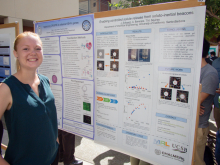
University:
Major:
Mentor(s):
Faculty Sponsor(s):
Faculty Sponsor's Department:
Project Title:
Project Description:
Equilibrium colloidal interactions are limited to £ 1 µm in water. However, in a recent study it was reported that colloidal particles can be designed to migrate over millimeter distances using specially engineered “soluto-inertial (SI) beacons”. These beacons establish and maintain a steady, non-equilibrium flux of solute over a long period of time, which exerts a force on the particles and causes them to migrate via diffusiophoresis. The release of solute from the beacon however is diffusion limited, which means that solute starts out-fluxing once the background solute concentration goes below its equilibrium value. In the current work, we design SI beacons that enable controlled solute release and therefore, on-demand migration of colloids. We use the thermo-sensitive polymer N-isopropylacrylamide (NIPAM) as the base material and make SI beacons in the form of hydrogels. These NIPAM beacons undergo a phase transition at a critical temperature above which they can arrest the release of solutes. We compare the solute release profile from NIPAM beacons to the non-thermo-sensitive polyethylene glycol-diacrylate (PEG-DA) beacons used in previous studies. Moreover, we design PEG-DA-NIPAM hybrid beacons to incorporate the thermo-sensitivity of NIPAM gels while maintaining the rigidity of PEG-DA gels. Eventually, we translate the setup to a µ-fluidic platform to study the interaction of the thermo-sensitive beacons with a suspension of colloids. We believe this feature in our beacon design will have tremendous impact on some of the applications that are critical to a number of industrial processes, such as triggering the flocculation of particles on-demand in wastewater treatment.
